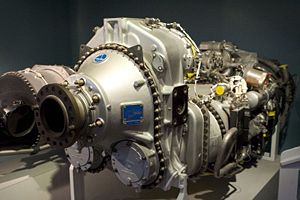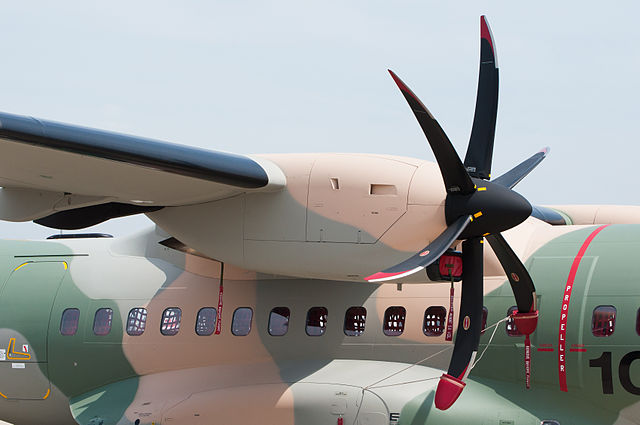Loading AI tools
Aircraft engine family From Wikipedia, the free encyclopedia
The Pratt & Whitney Canada PW100 aircraft engine family is a series of 1,800 to 5,000 shaft horsepower (1,300 to 3,700 kW) turboprops manufactured by Pratt & Whitney Canada. Pratt & Whitney Canada dominates the turboprop market with 89% of the turboprop regional airliner installed base in 2016, leading GE Aviation and Allison Engine Company.[2]
| PW100 | |
|---|---|
 | |
| PW120 in Canada Aviation Museum | |
| Type | Turboprop |
| National origin | Canada |
| Manufacturer | Pratt & Whitney Canada |
| First run | March 1981 |
| Major applications | ATR 42/ATR 72 De Havilland Canada Dash 8 EADS CASA C-295 Embraer EMB 120 Brasilia Fokker 50 Xian MA60 |
| Number built | >8,000 (as of 2014[update])[1][needs update] |
The engine was first introduced as a technology demonstrator in 1977.[3] The PW100 was first tested in March 1981, made its initial flight in February 1982 on a Vickers Viscount testbed aircraft,[4] and then entered service in December 1984 on a Dash 8 regional aircraft for NorOntair.[1]
The PW150 engine was introduced on 24 April 1995, when Bombardier selected the engine for the launch of its de Havilland Dash 8-400 regional turboprop. The PW150 was a higher-power version of the PW100 series, with the low-pressure compressor changed from a single-stage centrifugal compressor to a three-stage axial compressor, and the turbine modified to have improved cooling. The power rating was increased from 2,750 shaft horsepower (2,050 kilowatts) in the PW127 to 4,920 shp (3,670 kW) in the PW150, although the engine was thermodynamically capable of 6,500–7,500 shp (4,800–5,600 kW).[5]
At the 2021 Dubai Air Show, Pratt & Whitney Canada introduced the PW127XT (extended-time-on-wing) series. The PW127XT, which is intended to replace the PW127M variant, reduces the number of engine overhauls within 10 years to two from three. The engine maintenance interval (time-on-wing) is increased from 14,000 hours to 20,000 hours and would use three percent less fuel than the PW127M.[6] The engine series will premiere as the standard powerplant on all new ATR 42 and ATR 72 aircraft, with a launch order from Air Corsica using the PW127XT-M engine model. The PW127XT-N variant, which is designed for the ATR 72-600, has the same mechanical power rating as the PW127XT-M but has a higher thermodynamic power rating.[7]
Originally called the PT7, the PW100 uses a relatively unusual three-shaft engine configuration. In the PW100, a centrifugal low-pressure (LP) impeller (except for the PW150, which uses a 3-stage axial LP compressor), driven by a single-stage LP turbine, supercharges a contra-rotating centrifugal high-pressure (HP) impeller, driven by a single-stage HP turbine. Power is delivered to the offset propeller reduction gearbox through a third shaft, connected to a two-stage free (power) turbine. The gearbox has two stages, yielding a reduction ratio between 15.4 and 17.16. The first stage uses double helical gears, followed by a second stage with straight spur gears.[8]



The last two digits of each variant model number represent the nominal power at takeoff, in hundreds of horsepower.[9]
| Variant | Certification | Rating | Notes |
|---|---|---|---|
| PW115 | 1983-12[9] | 1,500 shp (1,100 kW)[11] | No longer in service. |
| PW118 | 1986-03-11 | 1,892 eshp (1,411 kW) | Can be converted to a PW118A. |
| PW118A | 1987-06-30 | 1,893 eshp (1,412 kW) | Can be converted to a PW118B. |
| PW118B | 1996-02-29 | 1,892 eshp (1,412 kW) | |
| PW119A | 1992-03-04 | 1,948 eshp (1,453 kW) | Can be converted to a PW119B. |
| PW119B | 1993-04-05 | 1,941 eshp (1,448 kW) | Can be converted to a PW119C. |
| PW119C | 1995-04-21 | 1,941 eshp (1,448 kW) | Can be converted to a PW119B. |
| PW120 | 1983-12-16 | 1,787 eshp (1,333 kW) | Can be converted to a PW121. |
| PW120A | 1984-09-18 | 1,892 eshp (1,411 kW) | Can be converted to a PW121. |
| PW121 | 1987-02-18 | 2,044 eshp (1,524 kW) | Can be converted to a PW120. |
| PW121A | 1995-03-24 | 1,992 eshp (1,465 kW) | |
| PW123 | 1987-06-30 | 2,261 eshp (1,687 kW) | Can be converted to a PW123B, C, D, or E. |
| PW123AF | 1989-06-14 | 2,261 eshp (1,686 kW) | Can be converted to PW123. |
| PW123B | 1991-12-20 | 2,262 eshp (1,687 kW) | Can be converted to a PW123. |
| PW123C | 1994-05-13 | 2,054 eshp (1,532 kW) | Can be converted to a PW123 or D. |
| PW123D | 1994-05-13 | 2,054 eshp (1,532 kW) | Can be converted to a PW123 or C. |
| PW123E | 1995-02-13 | 2,261 eshp (1,687 kW) | Can be converted to a PW123. |
| PW124B | 1988-05-25 | 2,522 eshp (1,881 kW) | Can be converted to a PW123 or PW127. |
| PW125B | 1987-05-01 | 2,261 eshp (1,687 kW) | |
| PW126 | 1987-05-01 | 2,323 eshp (1,732 kW) | Can be converted to a PW123 or PW126A. |
| PW126A | 1989-06-14 | 2,493 eshp (1,859 kW) | Can be converted to a PW123 or PW127D. |
| PW127 | 1992-02-04 | 2,619 eshp (1,953 kW) | Can be converted to a PW127C, E, or F. |
| PW127A | 1992-02-10 | 2,620 eshp (1,954 kW) | Can be converted to a PW127B. |
| PW127B | 1992-11-05 | 2,619 eshp (1,953 kW) | |
| PW127C | 1992-10-06 | 2,880 eshp (2,148 kW) | |
| PW127D | 1993-03-31 | 2,880 eshp (2,148 kW) | Can be converted to a PW127B. |
| PW127E | 1994-12-16 | 2,516 eshp (1,876 kW) | Can be converted to a PW127M. |
| PW127F | 1996-08-30 | 2,619 eshp (1,953 kW) | Can be converted to a PW127M. |
| PW127G | 1997-09-19 | 3,058 eshp (2,281 kW) | Used in CASA C295. |
| PW127H | 1998-10-23 | 2,880 eshp (2,148 kW) | |
| PW127J | 1999-01-04 | 2,880 eshp (2,148 kW) | |
| PW127M | 2007-12-07 | 2,619 eshp (1,953 kW) | Used in the ATR 72-600s. |
| PW127N | 2014-05-05 | 2,619 eshp (1,953 kW) | |
| PW127XT-L | 2023-08-28 | 2,619 eshp (1,953 kW) | Developed for use on STOL (short takeoff and landing) aircraft |
| PW127XT-M | 2022-08-25 | 2,621 eshp (1,954 kW) | Used in the ATR 72-600s. |
| PW127XT-N | 2023-06-22 | 2,621 eshp (1,954 kW) | |
| PW150A | 1998-06-24 | 5,492 eshp (4,095 kW)[12] | For the Q400 and An-132.[lower-alpha 1] |

| Application | Variant |
|---|---|
| Antonov An-132D | PW150A |
| Antonov An-140 | PW127A |
| ATR 42-300/320/400 | PW120/PW121 |
| ATR 42-500/600/600S | PW127E/XT-M/XT-L |
| ATR 72-100/200 | PW124B |
| ATR 72-500/600 | PW127F/XT-M |
| BAe ATP | PW126 |
| Canadair CL-215T | PW123AF |
| Canadair CL-415 | PW123AF |
| De Havilland Canada Dash 8-100 | PW120/PW121 |
| De Havilland Canada Dash 8-200/300 | PW123 |
| De Havilland Canada Dash 8-400 | PW150 |
| Dornier 328 | PW119 |
| EADS CASA C-295 | PW127G |
| Embraer EMB 120 Brasilia | PW118/118A/118B |
| Fokker 50/60 | PW125B/127B |
| Ilyushin Il-114 | PW127H |
| Xian MA60 | PW127J |
| Xian Y-7-200A | PW127C[32] |
| Series | Thermo. Power | Mech. Power | Prop. max. RPM | BSFC[lower-alpha 1][34] | Dry weight[34] | Height | Width | Length | Application |
|---|---|---|---|---|---|---|---|---|---|
| PW118 | 2,180 hp 1,630 kW | 1,800 hp 1,300 kW | 1,300 | 0.498 lb/(hp⋅h) 303 g/kWh | 861 lb 391 kg | 31 in 79 cm | 25 in 64 cm | 81 in 210 cm |
Embraer EMB-120 |
| PW120 | 2,400 hp 1,800 kW | 2,100 hp 1,600 kW | 1,200 | 0.485 lb/(hp⋅h) 295 g/kWh | 921 lb 418 kg | 31 in 79 cm | 25 in 64 cm | 84 in 210 cm |
ATR 42-300/320 Dash 8-100 |
| PW123/124 | 3,000 hp 2,200 kW | 2,400 hp 1,800 kW | 1,200 | 0.470 lb/(hp⋅h) 286 g/kWh | 992 lb 450 kg | 33 in 84 cm | 26 in 66 cm | 84 in 210 cm |
Dash 8-200/300 Canadair CL-215T/CL-415 |
| PW127 | 3,200 hp 2,400 kW | 2,750 hp 2,050 kW | 1,200 | 0.459 lb/(hp⋅h) 279 g/kWh | 1,060 lb 480 kg | 33 in 84 cm | 26 in 66 cm | 84 in 210 cm |
An-140, ATR 42-400/500/600, ATR 72-210/500/600 CASA C-295, Il-114-100, Xian MA60 |
| PW150 | 6,200 hp 4,600 kW | 5,000 hp 3,700 kW | 1,020 | 0.433 lb/(hp⋅h) 263 g/kWh[35] | 1,583 lb 718 kg[35] | 44 in 110 cm | 30 in 76 cm | 95 in 240 cm |
Dash 8-400 |
Data from PW100,[36] PW150[37]
Comparable engines
Related lists
Seamless Wikipedia browsing. On steroids.
Every time you click a link to Wikipedia, Wiktionary or Wikiquote in your browser's search results, it will show the modern Wikiwand interface.
Wikiwand extension is a five stars, simple, with minimum permission required to keep your browsing private, safe and transparent.